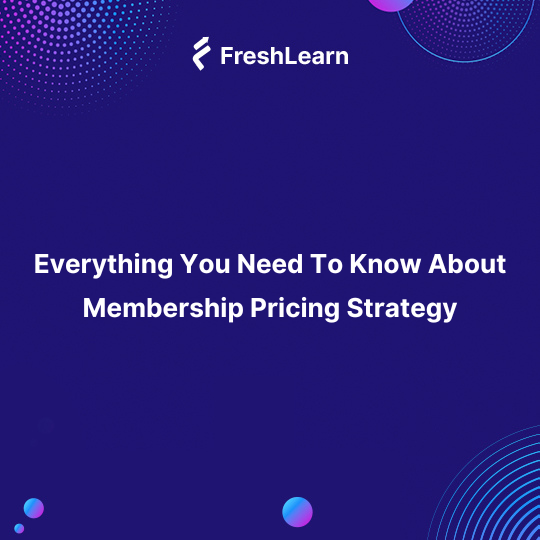
Everything You Need To Know About Membership Pricing Strategy
In the dynamic landscape of business, one key element often sets successful ventures apart from the rest – a well-crafted membership pricing strategy.
Guess what? A whopping 76% believe that subscription-based models are the key to retaining clients and developing long-term connections.
Organizations should carefully consider how they organize their membership fees if they hope to build enduring ties with their customers and produce steady revenue streams.
There isn't a single membership price that works for all businesses. Striking the correct balance between client value and corporate profitability is a tricky art, regardless of the type of business you run—a fitness center, software service, e-learning platform, or anything else.
This blog aims to explore the intricacies of membership pricing strategies, unraveling the core principles that drive success and the pitfalls to avoid.
Let's unlock the secrets to a membership pricing strategy that not only drives revenue but also cultivates a loyal and engaged customer base.
Understanding Membership Pricing Strategy
Membership pricing is a key component of business models across various industries, offering customers access to exclusive services, products, or content in exchange for a recurring fee.
Three common approaches to membership pricing are tiered pricing, freemium models, and fixed fee structures.
1. Tiered Pricing
Tiered pricing involves offering different membership levels or tiers, each with its own set of benefits and corresponding pricing.
Advantages:
- Provides customers with the flexibility to choose a membership level that aligns with their needs and budget.
- Encourages upselling as members may upgrade to higher tiers for additional benefits.
- Enables businesses to cater to a diverse customer base with varied preferences.
Example: Streaming services often employ tiered pricing, with basic, standard, and premium plans offering different levels of video quality, number of devices, and additional features.
2. Freemium Models
Freemium models offer both free and premium membership options. The basic services are available for free, while enhanced features or content are accessible through a paid subscription.
Advantages:
- Attracts a larger user base with the free offering, increasing the potential for upselling premium memberships.
- Allows customers to experience the product or service before committing to a paid subscription.
- Establishes a lower entry barrier, making it easier for customers to join and engage.
Example: Many mobile apps, such as gaming apps and productivity tools, use freemium models. Users can access basic features for free but can upgrade for an ad-free experience or additional functionalities.
3. Fixed Fee Structures
Fixed fee structures involve a consistent, unchanging membership fee for all subscribers, regardless of the level of usage or features accessed.
Advantages:
- Simplifies pricing for customers, eliminating confusion and making the decision-making process easier.
- Predictable revenue stream for businesses, facilitating financial planning and budgeting.
- Appeals to customers who prefer straightforward pricing without complexity.
Example: Gym memberships often follow a fixed fee structure. Members pay a set monthly fee for access to the gym and its facilities, regardless of how frequently they use them.
Factors Influencing Pricing Decisions (For Course Creators)
Setting the right price for your online courses is a critical aspect of your business strategy as a course creator. Various factors come into play when making pricing decisions, each influencing the overall success and profitability of your educational offerings.
Market Research and Analysis
Before you even think about pricing your courses, conducting thorough market research is essential.
Understanding the current trends, demands, and pricing strategies within the online education sector can provide valuable insights. Consider the following aspects during your market research:
- Perceived Value: Evaluate the perceived value of similar courses in the market. What features, content, or learning outcomes do they offer, and at what price? Understanding the value your competitors provide can help you position your courses effectively.
- Market Trends: Stay updated on emerging trends in online education. Are there specific topics or formats that are gaining popularity? By aligning your courses with market trends, you can cater to the demands of your target audience.
- Pricing Models: Explore different pricing models in the industry, such as one-time payments, subscription-based models, or tiered pricing. Consider what aligns best with your course content and audience preferences.
Also, if you're curious to know more about membership sites and how to create them, we've got a detailed blog that's just waiting for you. It's packed with all the details and insights you need
Understanding Target Audience
Knowing your target audience is crucial for making informed pricing decisions. Tailor your pricing strategy to cater to the needs and expectations of your specific demographic. Consider the following factors:
Demographics: Understand the age, profession, and educational background of your target audience. Different demographics may have varying budget constraints and willingness to pay for online courses.
Value Perception: Gauge how your target audience perceives the value of education. Some may be willing to invest more for premium content, while others may prioritize affordability.
Pain Points: Identify the pain points or challenges your audience faces in their learning journey. Your pricing strategy can address these pain points, offering solutions that resonate with your learners.
Competitor Benchmarking
Analyzing your competitors is an integral part of pricing decisions. By benchmarking against other course creators, you can position your offerings effectively within the market. Consider the following aspects:
Price Points: Compare the pricing of similar courses in your niche. If your courses offer unique value or additional resources, you may justify a higher price. Conversely, if you aim for affordability, ensure your pricing is competitive.
Promotional Strategies: Examine the promotional strategies employed by your competitors. Are they offering discounts, bundled packages, or limited-time promotions? This information can help you fine-tune your own marketing and pricing tactics.
Differentiation: Highlight what sets your courses apart from the competition. Whether it's exclusive content, interactive features, or personalized support, emphasizing your unique selling points can justify premium pricing.
How to Charge Membership Fees Effectively
1. One-Time Payment vs. Subscription Models
Choosing between a one-time payment and a subscription model is a critical decision when establishing membership fees. A one-time payment might be suitable for organizations offering lifetime benefits or access to a specific set of resources.
On the other hand, subscription models provide a steady stream of income and often align with ongoing services or exclusive content. Careful consideration should be given to the nature of the membership benefits and the sustainability of the organization's offerings.
It's essential to strike a balance that reflects the value members receive while ensuring the financial stability of the organization.
2. Setting Initial Fees and Renewal Charges
Determining the initial membership fees and renewal charges requires a strategic approach. The fees should be perceived as reasonable by potential members, considering the benefits offered.
Conducting market research to understand industry standards and competitors' pricing can guide the establishment of a competitive yet attractive fee structure. Additionally, organizations must evaluate the renewal charges to encourage member retention.
Offering incentives such as discounts for early renewals or loyalty rewards can create a positive atmosphere and enhance the perceived value of continued membership.
3. Incorporating Flexibility for Growth
Flexibility is key when charging membership fees, especially for organizations experiencing growth or diversifying their offerings. Implementing tiered membership levels allows for scalability and accommodates members with varying needs and budgets.
As members progress through different levels, they should experience increasing value and benefits. Moreover, flexibility should extend to payment options, offering quarterly, semi-annual, or annual plans to cater to diverse financial preferences.
Regularly reassessing and adjusting the fee structure based on member feedback, market trends, and organizational growth ensures that the membership model remains adaptive and sustainable over time.
This adaptability fosters a dynamic relationship between the organization and its members, promoting long-term engagement and satisfaction.
Implementing Your Membership Pricing Strategy
Implementing your membership pricing strategy involves several key steps to ensure a smooth transition and successful adoption by both existing and potential members.
1. Setting Up Payment Gateways
Setting up payment gateways is a crucial first step in implementing your membership pricing strategy. Choose reliable and secure payment processing systems that align with your business needs.
Integration with various payment methods allows for flexibility and convenience for your members. Ensure that the payment gateways comply with industry standards for security to safeguard sensitive financial information.
Clear communication about the payment process and any changes is essential to build trust with your members.
2. Communicating Changes to Existing Members
Communicating changes to existing members is vital to minimize confusion and maintain transparency. Clearly outline the reasons behind the pricing adjustments, emphasizing the enhanced value they will receive.
Utilize various communication channels such as emails, newsletters, and your website to convey these changes effectively. Provide a timeline for the transition, and offer support channels for members to address any concerns or queries they may have.
Open and honest communication fosters a positive relationship with your existing membership base.
3. Marketing Strategies for New Pricing Plans
Implementing effective marketing strategies for new pricing plans is essential to attract and retain members. Craft compelling messages highlighting the benefits and value proposition of each pricing tier.
Utilize targeted advertising through online platforms, social media, and other relevant channels to reach your target audience. Consider offering limited-time promotions or discounts for early adopters to incentivize sign-ups.
Leverage testimonials or success stories from existing members to build credibility and showcase the positive impact of your membership plans.
Wrapping Up
Creating a successful membership pricing strategy is like navigating a dynamic and intricate maze. It is not a one-size-fits-all situation; you must thoroughly grasp your target audience, keep an eye on the market, and highlight what distinguishes your firm.
We've discussed this extensively on the blog, but the idea is to continuously refine and enhance your plan as things evolve.
A smart membership pricing plan isn't just about money – it's about building a strong connection with your members. When you set your prices based on what your members think the perks are worth, it becomes a win-win.
Members feel like they're getting a great deal, and your organization gets a reliable income stream. The key is to identify the perfect spot where everyone is content and involved.
If you're looking to craft a fantastic membership site, you might want to check out Freshlearn. It's a great platform that can help you create an amazing membership experience for your audience.
FreshLearn isn't your run-of-the-mill course platform – it's the ultimate toolkit for creators building vibrant membership sites. Here's a quick tour:
Content Variety: Ditch the monotony. FreshLearn serves up a buffet of content – blogs, podcasts, webinars – to keep your members hooked.
Drip Content: Build suspense by scheduling content releases. Drop new lessons, articles, or exclusive insights to keep members coming back for more.
Community Vibe: It's not just a site; it's a hangout. FreshLearn hooks you up with forums and chat rooms to foster a sense of community.
Membership Levels: Customize plans with different access and perks. Think of it as creating your own exclusive club.
Brand Swagger: Stamp your style. Upload your logo, play with colors and fonts – make it uniquely yours.
Integrations: Sync up with your favorite tools seamlessly for a smooth operation.
No Fee Sneak Attacks: Keep all your hard-earned cash. FreshLearn doesn't slice into your sales – 100% is yours.
In a nutshell, FreshLearn is the real deal for creators wanting to turn their passion into a buzzing online community. It's got the features, the flair, and the promise of a full pocket. Consider it your creative sidekick. Sign Up Today!


